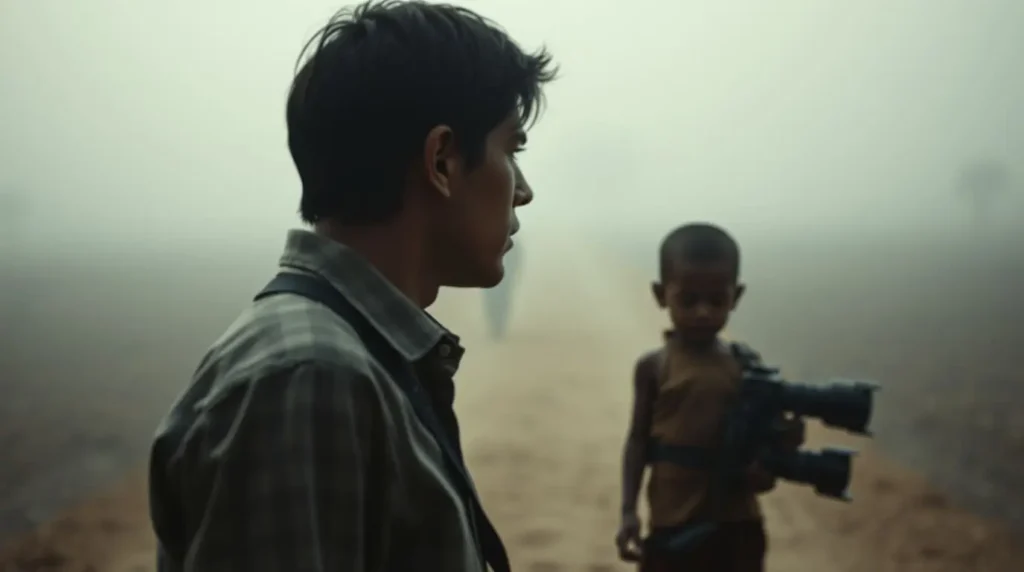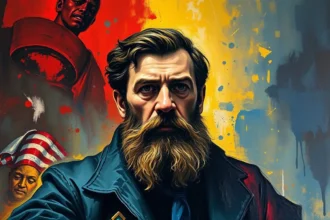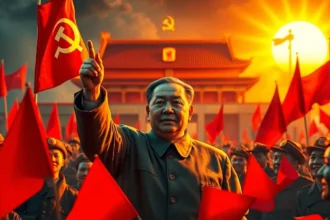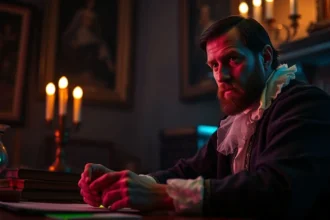In 1993, South African photojournalist Kevin Carter captured an image that would become one of the most iconic and controversial photographs in modern history. Taken during a famine in Sudan, the image depicts a frail child, emaciated and struggling to reach a feeding center, while a vulture looms menacingly in the background. This haunting photograph not only brought Carter the Pulitzer Prize but also cast him into the heart of an ethical and emotional storm—a dilemma that would ultimately lead to his tragic demise.
There is a tension between the need to bear witness and the need to intervene.
Susan Sontag, from Regarding the Pain of Others.
This blog explores Kevin Carter’s life, the events surrounding the photograph, the moral questions it raised, and the enduring legacy of his work and personal struggles.
A Photographer in a World of Conflict
Kevin Carter was born in 1960 in apartheid-era South Africa. Growing up in a racially divided society, Carter became deeply aware of social injustices from an early age. In the 1980s, he began documenting the violence and oppression of apartheid, working alongside other daring photographers who called themselves the “Bang-Bang Club.” These photojournalists risked their lives to capture the raw, unfiltered reality of racial conflict in South Africa.

Carter’s work in South Africa earned him recognition, but it also subjected him to profound psychological trauma. Witnessing death, suffering, and violence daily left emotional scars that would later play a significant role in his personal struggles.
The Fateful Photograph in Sudan
In March 1993, Carter traveled to Sudan to document the country’s devastating famine as part of a UN mission. During his visit to a village near Ayod, he stumbled upon a heart-wrenching scene: a small girl, weakened by starvation, was crawling toward a feeding center. As Carter prepared to photograph the child, a vulture landed nearby, watching her intently. The stark imagery of desperation, helplessness, and predation struck Carter profoundly.
Carter reportedly spent 20 minutes composing the photograph, waiting for the vulture to spread its wings for a more dramatic effect, but it never did. He eventually snapped the picture and chased the vulture away. The photograph was later published in The New York Times, where it instantly drew global attention.
The Ethical Debate: To Shoot or to Save?
The image sparked an intense ethical debate. Many viewers were moved to tears, but others questioned the role of the photographer in such situations. Should Carter have done more to help the child? Was it ethical for him to take the photo and leave? These questions have haunted photojournalism as a profession, raising critical dilemmas about the balance between bearing witness to suffering and intervening directly.

Carter explained that journalists were often instructed not to intervene in such situations, partly due to the risk of spreading disease and partly because their primary role was to document and raise awareness. In this case, the child was reportedly near a feeding center and under the care of aid workers, but this did little to assuage critics. The image became both a call to action and a point of contention about the limits of professional detachment.
Fame and Fallout
Carter’s photograph won the Pulitzer Prize for Feature Photography in 1994, cementing his place in the annals of photojournalism. However, the fame was a double-edged sword. While the Pulitzer recognized his artistic and journalistic achievement, the criticism surrounding the photograph exacerbated Carter’s emotional turmoil. He was accused of exploiting the child’s suffering for personal gain, a charge that cut deeply.
The camera is an instrument that teaches people how to see without a camera.
Dorothea Lange, renowned documentary photographer.
The backlash intensified Carter’s struggles with depression and self-doubt. He had long battled feelings of guilt and inadequacy from his experiences in South Africa and elsewhere. The controversy surrounding the Sudan photo magnified these inner demons, leaving Carter overwhelmed by the weight of his experiences.
The Tragic End
On July 27, 1994, just months after receiving the Pulitzer Prize, Kevin Carter took his own life. In his suicide note, he expressed feelings of deep despair, haunted by vivid memories of suffering and violence. He wrote, “I am haunted by the vivid memories of killings and corpses and anger and pain… of starving or wounded children, of trigger-happy madmen.”
Carter’s death sent shockwaves through the photojournalism community and beyond, sparking a broader discussion about the mental health challenges faced by journalists who work in conflict zones. His story highlighted the immense emotional toll of witnessing human suffering and the lack of adequate support systems for those who document it.
The Legacy of the Photograph
Kevin Carter’s photograph remains one of the most debated images in the history of photojournalism. It continues to serve as a powerful reminder of global inequality, the human cost of famine, and the ethical complexities of documenting suffering. The image catalyzed increased humanitarian aid to Sudan and inspired countless discussions about the role of journalists in crisis situations.

However, Carter’s story also underscores the need for greater awareness of the mental health challenges faced by journalists. Today, organizations like the Dart Center for Journalism and Trauma provide resources to help journalists cope with the psychological impact of their work, but there is still much to be done.
Lessons from Kevin Carter’s Dilemma
Carter’s story raises profound questions that resonate beyond photojournalism:
- The Ethics of Observation: How can journalists and photographers balance the need to document suffering with their moral responsibility to intervene? Where do we draw the line between storytelling and exploitation?
- The Weight of Witnessing: What can be done to support individuals who bear witness to humanity’s darkest moments? Carter’s struggles highlight the importance of mental health resources for those who work in high-stress, emotionally taxing environments.
- The Power of Images: Despite the controversy, Carter’s photograph succeeded in bringing global attention to a crisis that might have otherwise gone unnoticed. It exemplifies the unique power of visual storytelling to provoke action and empathy.
Breaking Down the Barrier
Kevin Carter’s life and work remain a poignant testament to the power and perils of photojournalism. His Pulitzer Prize-winning photograph captured the world’s attention, forcing millions to confront the grim realities of famine and suffering. At the same time, his tragic end reminds us of the immense emotional toll of witnessing and documenting human misery.
Carter’s story is not just a cautionary tale but also a call to action—for greater compassion, ethical reflection, and support for those who dedicate their lives to shedding light on the world’s injustices. As we reflect on his legacy, we are reminded of the enduring power of photography to move, provoke, and challenge us—and of the human cost borne by those behind the lens.
Additional Resources
Here are curated additional resources with working hyperlinks to deepen your understanding of Kevin Carter, his famous photograph, and the ethical dilemmas surrounding photojournalism:
Books and Biographies
- The Bang-Bang Club: Snapshots from a Hidden War by Greg Marinovich and João Silva
A gripping account of Kevin Carter and his fellow photojournalists documenting apartheid-era violence. - Photojournalism and Today’s News by Loup Langton
Explores the challenges and ethics of modern photojournalism, including cases like Kevin Carter’s. - Witness in Our Time by Ken Light
Profiles of contemporary photojournalists, touching on the moral and personal struggles of documenting conflict.
Online Articles and Analysis
- The Life and Legacy of Kevin Carter – Time Magazine
An in-depth feature reflecting on Carter’s Pulitzer Prize-winning photo and its aftermath. - The Ethics of Photojournalism – The Atlantic
A broader exploration of the moral dilemmas faced by photographers in conflict zones. - Kevin Carter and the Cost of Bearing Witness – The New York Times
An editorial examining the emotional toll of Carter’s work and its impact on photojournalism.
Documentaries and Videos
- The Death of Kevin Carter: Casualty of the Bang-Bang Club – PBS
An Oscar-nominated documentary delving into Carter’s life, work, and tragic end. - Through a Lens Darkly – A YouTube documentary analyzing the ethical dimensions of Carter’s photograph.
- Witnessing the World: Photojournalists at Risk – National Geographic
Explores the challenges and emotional impact of documenting human suffering.
Ethics and Journalism Resources
- The Dart Center for Journalism and Trauma
Resources and support for journalists coping with the psychological effects of covering conflict and tragedy. - National Press Photographers Association (NPPA) Code of Ethics
Outlines ethical guidelines for photojournalists, including discussions on intervention versus documentation. - World Press Photo Ethics Guidelines
A framework for understanding the responsibilities of photographers in crisis zones.
Free Online Texts and Case Studies
- The Pulitzer Prize Winners: Kevin Carter’s Photo
The official Pulitzer archive featuring Carter’s iconic image and background. - The Role of Photography in Humanitarian Awareness
A historical perspective on how images shape public consciousness. - Case Study: The Vulture and the Little Girl – International Committee of the Red Cross
An ethical analysis of Carter’s photograph and its implications for humanitarian work.
Academic Articles and Journals
- The Psychological Impact of Photojournalism – JSTOR
Research articles examining the mental health challenges faced by conflict photographers. - Images of Suffering: Ethics in Visual Journalism – Springer
Scholarly work on the moral questions raised by iconic photographs like Carter’s. - The Power of the Image: Photojournalism and Social Change – Taylor & Francis
Articles exploring how visual media influences public opinion and policy.
Interactive Resources
- Interactive Timeline of Kevin Carter’s Life – Biography.com
A timeline covering key milestones in Carter’s career and personal struggles. - Iconic Photos in Photojournalism
Features Carter’s work alongside other impactful images, with historical context. - Explore the Ethics of Photojournalism – Nieman Reports
A digital resource for understanding the complexities of documenting human tragedy.
These resources provide a rich foundation for exploring Kevin Carter’s story, the ethical challenges of photojournalism, and the broader implications of documenting human suffering. Let me know if you’d like further recommendations or assistance!
Must Read: Mao Zedong












